Ensoniq EPS- Owned from February 2001-present, bought for $150
In its day the EPS was ahead of its time. Most would disagree but I think it's still very useful today, though it's better used as a synthesizer than a sampler. It has a few very interesting and unique features found in few, if any, modern samplers.
The voice architecture is nice. There are 20 voices total (or 12 or 16 depending on output sample rate) and each sound can have 8 layers (these steal polyphony- with 4 layers it's only 5 voice polyphonic). There are 2 patch select buttons by the pitch/mod wheels which can be used to turn layers on and off. Layers can be triggered by note on or note off messages. Each layer acts as an independent voice, and can contain up to 128 samples (I think) which can have completely different settings for everything. There are 3 6-stage loopable envelopes, with independent level curves for low velocity and high velocity, keyboard rate scaling, etc. There are lots of very useful preset envelope templates, too. ENV1 has a fixed routing on the pitch page, ENV2 to the filters, and ENV3 is fixed to the amplitude. There is one LFO, with saw, square, triangle, sine, and sin/tri waves, some with positive-only waves. There's a simple delay parameter, and it can be set to reset with each key press, run free, or slowly vary in speed (humanize). Unfortunately the speed parameter can't be adjusted in realtime, but the envelopes can. The pitch page contains typical tuning parameters, and a nice sample and hold modulation source. Unfortunately it can't be modulated by anything. The filter page has an interesting multi-mode filter with various combinations of 1, 2, and 3-pole high or lowpass filters (2 filters in series, adding up to 4-pole total). They can be modulated independently. They aren't resonant but they are still fairly useful. The amp page has settings for panning/output assignment (panning can't be modulated but it can follow the keyboard), a velocity range for which the layer sounds (for velocity switching), and a few interesting settings for complicated modulated crossfades. The layer page has portamento settings (mono only) and a setting for selecting scales- either standard, no pitch, or a scale that's in RAM (yes, microtonal scales can be programmed). But the wave page is the most interesting. This is where all the looping parameters are. Forward with no loop, reverse with no loop, forward loop, forward loop and release, and bidirectional loop are the basic looping modes. Then there are settings for sample start/end, and loop start/end and loop position. Then a page where the loop start and/or position can be modulated by any source. This is the transwave section, which has some really, really interesting possibilities. Theoretically it's possible to timestretch sounds this way, but since the EPS does it rather primitively, the zero-crossing points have to be at consistant intervals through the entire sample or it will have clicks and glitches. Even when the waveform is perfect it can have problems. What I find really interesting is using relatively small waveforms and modulating the waveshape- good PWM effects are very easy to obtain by using a square wave, and samples of pitch sweeps give nice oscillator sync sounds. Or it's possible to take a small piece of any sample, bidirectionally looped, and modulate the loop position to obtain very very nice PPG-sounding wavetable effects. Doing this modulates the waveshape and gives very nice evolving sounds. Or it's possible to use fairly long loops on big waveforms to get randomized glitch effects. Finally, when loop points are too close together, the EPS tends to mess up and play parts of its RAM randomly. This can give a lot of strange and interesting effects, though it's rather unpredictable.
The EPS also features a good deal of wave editing functions, including normalization, compression, copy, paste, truncate, combine, splice, etc. There are also some interesting looping algorithms. These are non-realtime processes that are performed on a sample to help it loop more smoothly. There are various crossfade algorithms, and one to make a loop longer. But the most interesting one is "synthesized loop", which is supposed to be able to get a smooth loop out of any sound by randomly crossfading parts of the waveform together. There are 5 settings from "very smooth" to "very coarse", which controls how big the chunks are. This algorithm doesn't always produce good results, but a lot of times it can be interesting for making a "bowed piano" sound or making a drum hit into a wash of noise.
The EPS also has a nice 8/16-track sequencer that is very easy to use. 8 tracks use patterns which are arranged into songs and 8 are linear "song tracks" which are recorded over a whole song. The pattern-based tracks and the song tracks share the same instruments and controller data, but it can be used as 16 virtual tracks by using keyboard splits. There's a metronome, and typical pattern editing features- quantize, merge, clear, remove controller, etc. There's a step edit function which can add/remove notes and edit velocity. It isn't terribly advanced but it's nice enough. One thing it's missing is a swing function.
The keyboard of the EPS is very nice, sort of semi-weighted, made by Fatar. The keys are kind of clicky but they feel good. The best part is polyphonic aftertouch- I believe Ensoniq was the only company to figure out how to do it cheaply (Several other keyboards have poly aftertouch, like the Kurzweil Midi Board and the Sequential Circuits Prophet T8, but the mechanisms were very complicated and expensive). There actually aren't any key contacts. Attatched to each key is a metal plate and a foam pad, and inductive sensors under each key. The keyboard has its own CPU which calculates velocity and aftertouch data from these sensors. After loading the OS the keyboard calibrates- I assume this means that it gets a reading from each key, so it's important at this point to not have any keys held down. Unfortunately the poly aftertouch keyboards in a lot of models are made with two separate boards, and they fail when the solder connections between the boards break. When this happens the keyboard calibration will fail. It's not hard to repair but it's a pain to remove all the keys to get to it. Luckily I haven't had any problems with mine.
Inside the EPS has a power supply which gets very hot, I have an old computer fan aimed at the heatsink on mine to keep it reasonably cool. The CPU is a Motorola 68000. The sound generating chip is called the DOC-II or OTTO chip, and it contains all the filters, sound generation stuff, DAC, etc. Then it goes to a demultiplexer for panning and individual outputs (The EPS only has stereo outs but there's an output expander which adds 8 more.). There's about 512K of RAM stock, which can be upgraded to about 1MB with the 2x memory expander or about 2MB with the 4x memory expander. SCSI is available too, but I've heard it only works with certain drives.
There is a hidden menu which can be accessed in the Command- ENV1 section. There are, among other things, the names of the hardware/software designers, controller tests, and a keyboard calibration command.
Overall it's an old but still very useful sampler. I've heard that the only other things that can do transwave modulation besides Ensoniqs are the Waldorf Wave and Reaktor. The EPS 16+ is a nice alternative, and fairly cheap now. The rack versions are good too, as they include the memory expander, output expander, and SCSI built in.
pictures: note the bizarre crash message in the fourth one (it does that kind of thing a lot), the keyboard hardware in the sixth and seventh, and the piece missing from the RAM chip (!) in the eighth.
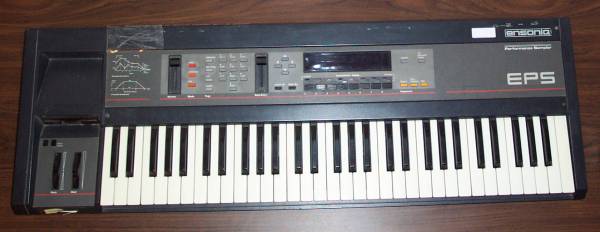

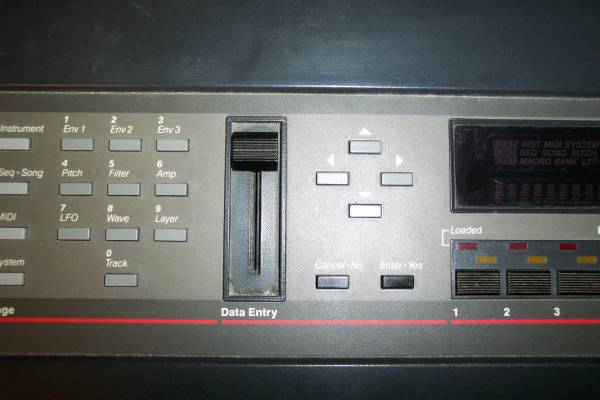
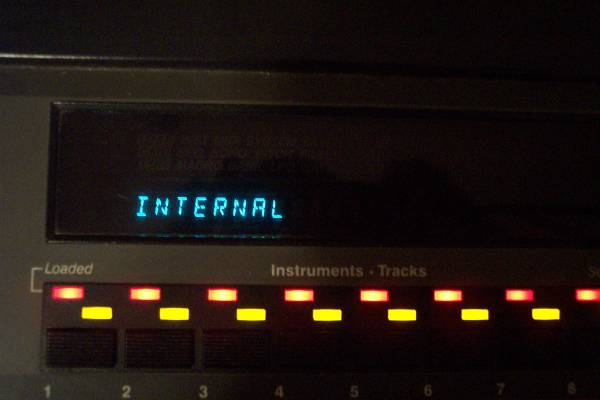
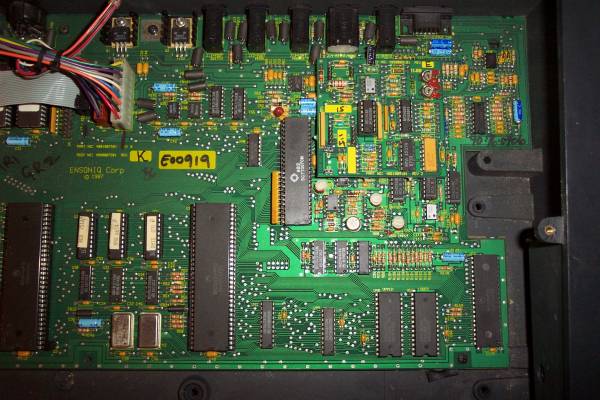
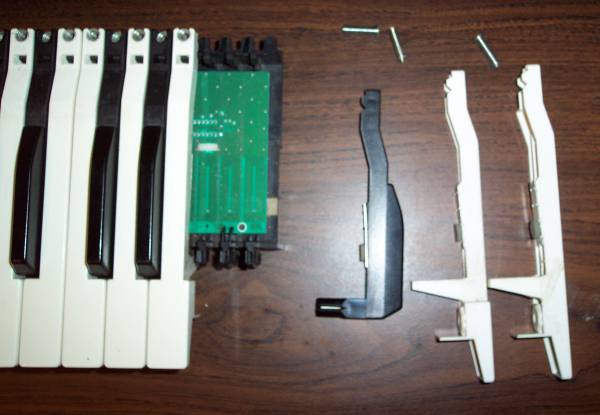
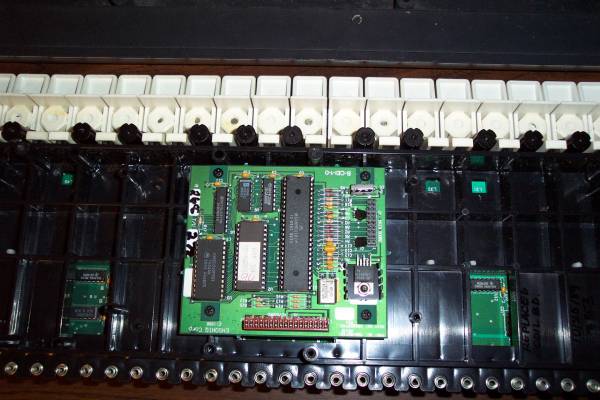
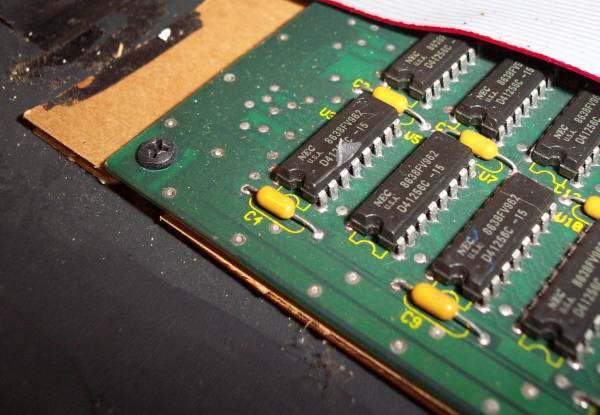
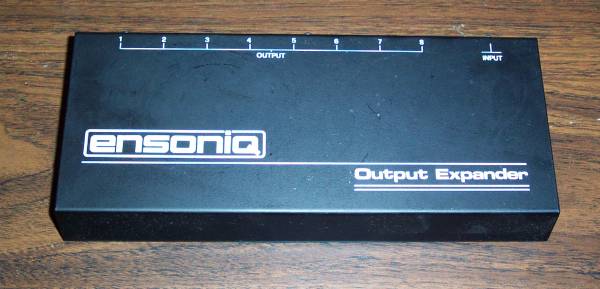
sounds:
EPS-1- a quick and not very good demo of melodic transwave sounds. The sound was based on a TB-303 sample.
EPS-2- a noisy weird demo of transwave sounds. I think it was originally a sample of the circuit-bent SA-5 but it's so mangled that it doesn't really matter.
And there's another demo here
links:
There's a neat transwave-creation program here: Tranzilon - Info
There's a very large Ensoniq sample database here: SoundCentral - Main Page
EPSDisk (very useful), operating systems, manuals here: Ensoniq EPS-SQUARE
Useful information and products: Rubber Chicken - Chicken Systems Home Page
back to synth index
